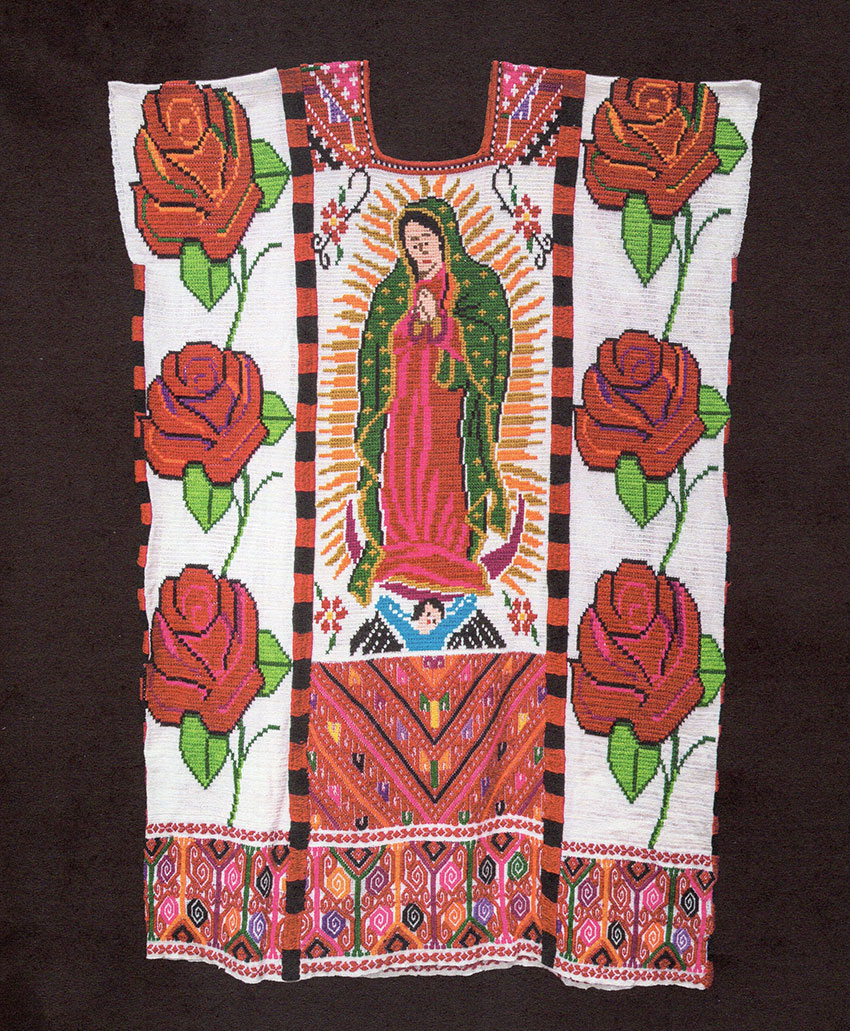After the Conquest the Spanish imposed many of their cultural norms on the people of what is now Mexico, not in the least related to dress. As a result, many of the traditional indigenous garments seen today show European influence and even origin.
But some truly indigenous garments still survive.
Among them are wrap belts, wrap skirts, quexquemitls — a poncho-like garment, and huarache sandals.
The most important of these, however, is likely the huipil, a garment seen from central Mexico into Central America, indicating the extension of Mesoamerica. In Mexico, its use distinguishes the indigenous peoples of central and southern Mexico from those in the north. Evidence of the garment’s use goes back as far as 900 B.C., but its history is probably older.
The basic concept is simple. A long rectangular piece of cloth is folded over lengthwise to form a tunic-like garment. An opening is made for the head, with the sides sewn most of the way leaving space for the arms to come through.

It is shapeless in the sense that it not cut to follow the contours of the human body. This is not because Mesoamerican cultures never figured out how to cut cloth. Rather, it is because such cloth was all woven by hand, and therefore very precious, similar to the rationale of the clothing worn by the ancient Greeks.
Perhaps because they are not seen as often by foreign tourists they are relatively unknown, especially compared to the blouse/skirt combination worn by mestizo women and many indigenous as well.
Despite their simple shape, a true huipil is neither quick to make nor cheap. The best are still hand woven on backstrap looms in complicated brocades and embroidered, meaning months of work. Such are not everyday garments, but rather for special occasions or they are made to earn money for the family.
Huipils can be long or short. The long ones are worn like dresses, and the short ones like blouses, with a wrap or European-style skirt. How they are designed and worn is dictated by community and tradition. This means that the community and the status of the woman wearing the garment can be discerned by it.
Although embroidery can and is done on all kinds of garments in Mexico, huipils provide a rather large canvas for large and/or repeating designs. Anthropologist Marta Turok states that “Huipils are part of a living legacy with profound cultural meaning. Most of the woven-in designs are sacred symbols and they represent the vast diversity of over 60 ethnic groups in Mexico.” Her groundbreaking work in the 1970s brought this symbology to light.
Huipils can be made from a single piece of cloth, but the longer ones are commonly made with three lengths of narrow cloth that have been decoratively stitched together. This is because the backstrap loom limits the width of the cloth that can be made.

There are some garments that may not be true huipils but are related to or derived from them. One is the Tehuana woman’s headdress, made famous by Frida Kahlo’s painting of herself wearing one. On the Yucatán Peninsula, the traditional dress is called the hipil (a variation of the word “huipil”) or the terno.
It is worn by mestizo women, not indigenous, and has three parts. The jubon is a free-falling yoke. This is attached to the “huipil” which hangs from the shoulders to the knees. The last is the fustan, a half-slip worn underneath that hangs lower than the huipil. All three are heavily embroidered and usually decorated with lace as well.
In the former Purépecha empire (today’s Michoacán), there is a garment called a huanengo or guanengo. There is some debate as to whether it should be classified as a variation of the huipil. It is always worn as a blouse but some variations look very much like huipils, some even having three sections. Others show strong influence from European yoked blouses, with simple sleeves.
For foreigners who visit huipil-wearing areas, the shorter blouse versions are the most popular, as these can easily be worn with jeans. Handcraft aficionados tend to buy and wear the longer versions as well. There have been recent controversies related to the copying of Mexican traditional garments by designers for foreign markets.
Such objections do not seem to indicate that there is a problem with “cultural appropriation” when foreigners buy and wear traditional clothing made in Mexico. Octavio Murrillo Álvarez of the National Institute of Indigenous Peoples (INPI) says that in his personal interactions he has not come across objections from Mexico’s native peoples in relation to non-indigenous wearing huipils or other similar items.
One obvious benefit is that it allows textile artisans to earn money for their work. Another may be that it helps make the wearing of such garments less stigmatized for the indigenous themselves, which unfortunately it is in much of Mexico.
Leigh Thelmadatter arrived in Mexico 17 years ago and fell in love with the land and the culture. She publishes a blog called Creative Hands of Mexicoand her first book, Mexican Cartonería: Paper, Paste and Fiesta, was published last year. Her culture blog appears weekly on Mexico News Daily.
